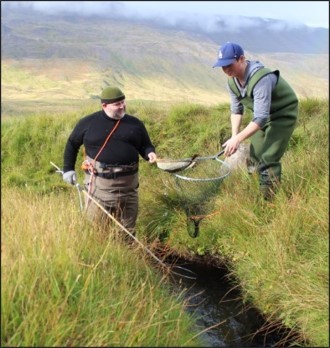Divergence Makes the Genome Wander: What an Icelandic Fish is Teaching Scientists About Evolution
By Shelby Bohn
4 January 2023

Figure 1. Dr. Matthew Brachmann and colleague Dr. Bjarni Kristjansson capture Arctic charr in Iceland. Photo: Matthew Brachmann.
Thanks to Iceland’s unique geologic history, lake-living Arctic charr are giving researchers in the Department of Integrative Biology new insight into how one species may eventually diverge into several.
Arctic charr are one of only six freshwater species in Iceland. These charr have been able to broaden their ecological horizons in ways that might not have been possible if there were other species of fish present to contend with. This makes them particularly helpful in answering questions about the relationship between habitat use, physical appearance, and genetic differences.
“We know from previous work that Arctic charr came from a single glacial refuge in Iceland,” says Dr. Matthew Brachmann, a recent PhD graduate supervised by Dr. Moira Ferguson. After being trapped by glaciers in the country’s lakes 10,000 years ago, the fish continued to evolve into the different “morphs” of Arctic charr we see today.
You might be familiar with morphs if you’ve ever noticed the different fur colours of Eastern grey squirrels. Morphs are different versions of the same species that can differ in appearance, behaviour, or lifestyle.
In Iceland, there are two different morphs of Arctic charr that are named after the regions of the lakes they inhabit. “Benthic” morphs eat deep water invertebrates like snails near the lake bottom, while “pelagic” morphs eat zooplankton and fish out in the open water.
Much like the different handling capabilities between a smart car and a race car, both of these morphs have body shapes that help them navigate their habitats of choice. Benthic morphs have stocky, maneuverable bodies that allow them to navigate clutter at the bottom of the lake, and pelagic morphs have sleek bodies efficient at swimming in the open water.

Figure 2. Different morphs of Icelandic Arctic charr. Top row: benthic morphs; bottom row: pelagic morphs. Photo: Matthew Brachmann.
While these morphs are still one species, the differences between them, or “divergence” may hint at the early stages of speciation. For now, the DNA of these fish suggest there is still some genetic mixing between morphs — although Brachmann notes that the degree of mixing varies across different lakes.
“Some lakes have morphs that reproduce with each other and use overlapping habitat, while other lakes have less and less mixing, including lakes with morphs that are almost entirely separate,” Brachmann says.
The differences between lakes are partly because of the habitat characteristics like how much food the fish are getting. In larger lakes, there tends to be more food available and there are more available niches for the morphs to specialize – factors that influence how likely it is the different morphs will reproduce together.
Interestingly, the differences between benthic and pelagic morphs are similar across the different lakes in Iceland. A benthic morph from one lake looks like a benthic morph from another – but not because they are genetically similar.
“If you look at the two morphs in one of the lakes and compare to two morphs in another lake, they’re completely different genetically! So, they’re ecologically parallel, but genomically they’re not.”
In other words, fish from different lakes appear to arrive at the same physical appearance via different genetic routes. And since selection is not a random process, this suggests there are similar selection pressures in each lake that are causing the charr to repeatedly differentiate into the benthic and pelagic morphs, even though they have different genetic information.
Says Brachmann, "Selection is basically repeatedly driving the characteristics of these morphs and that makes them a good study system.”
This work is the first extensive genomic study to compare Icelandic Arctic charr across lakes, and Brachmann is thrilled the results have now been published.
“Overall, this study provides novel insights into how large scale genomic differentiation occurs, helping us understand how and why new species evolve.”
This study was funded by the Natural Science Engineering Research Council (NSERC)
Read the full study in the journal of Molecular Ecology.
Read about other CBS Research Highlights.